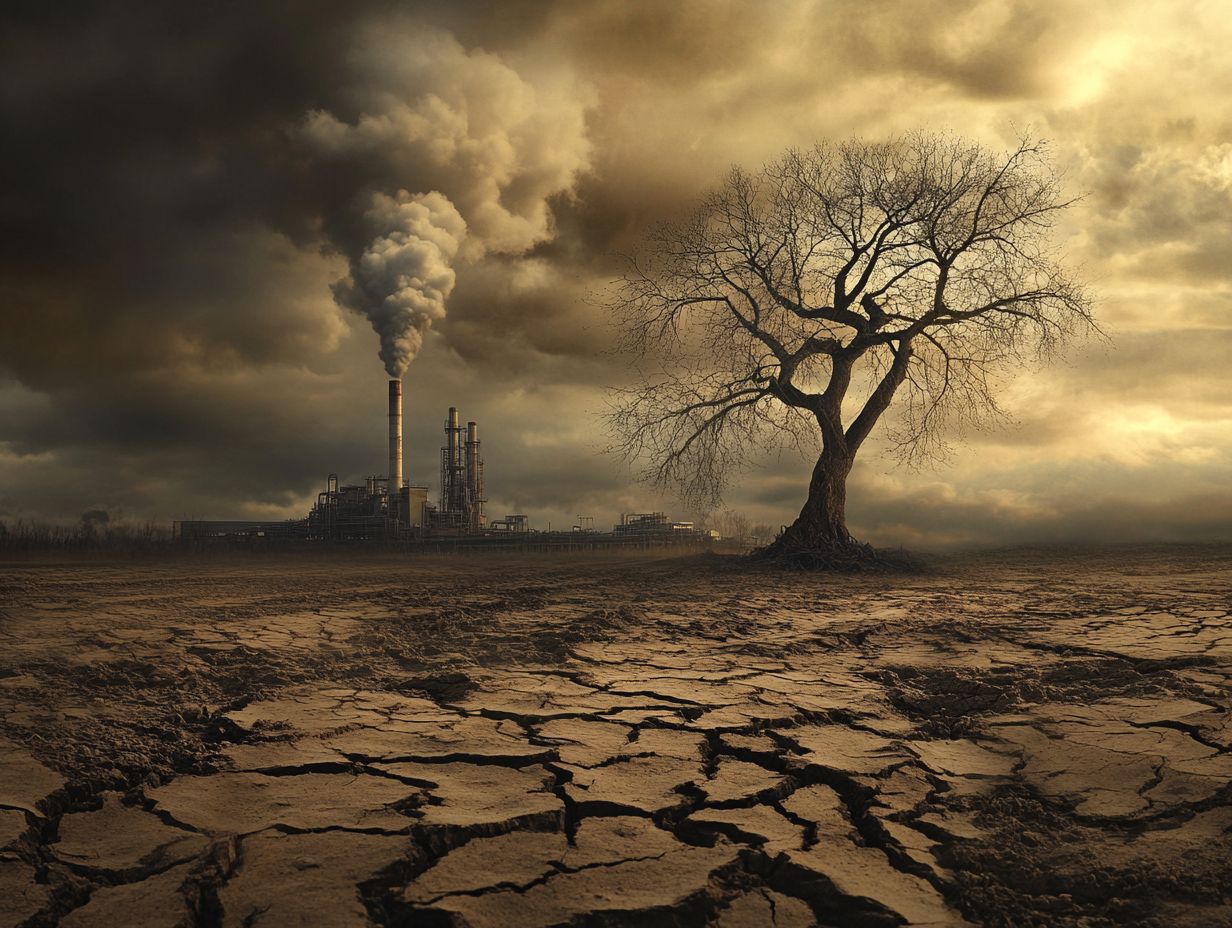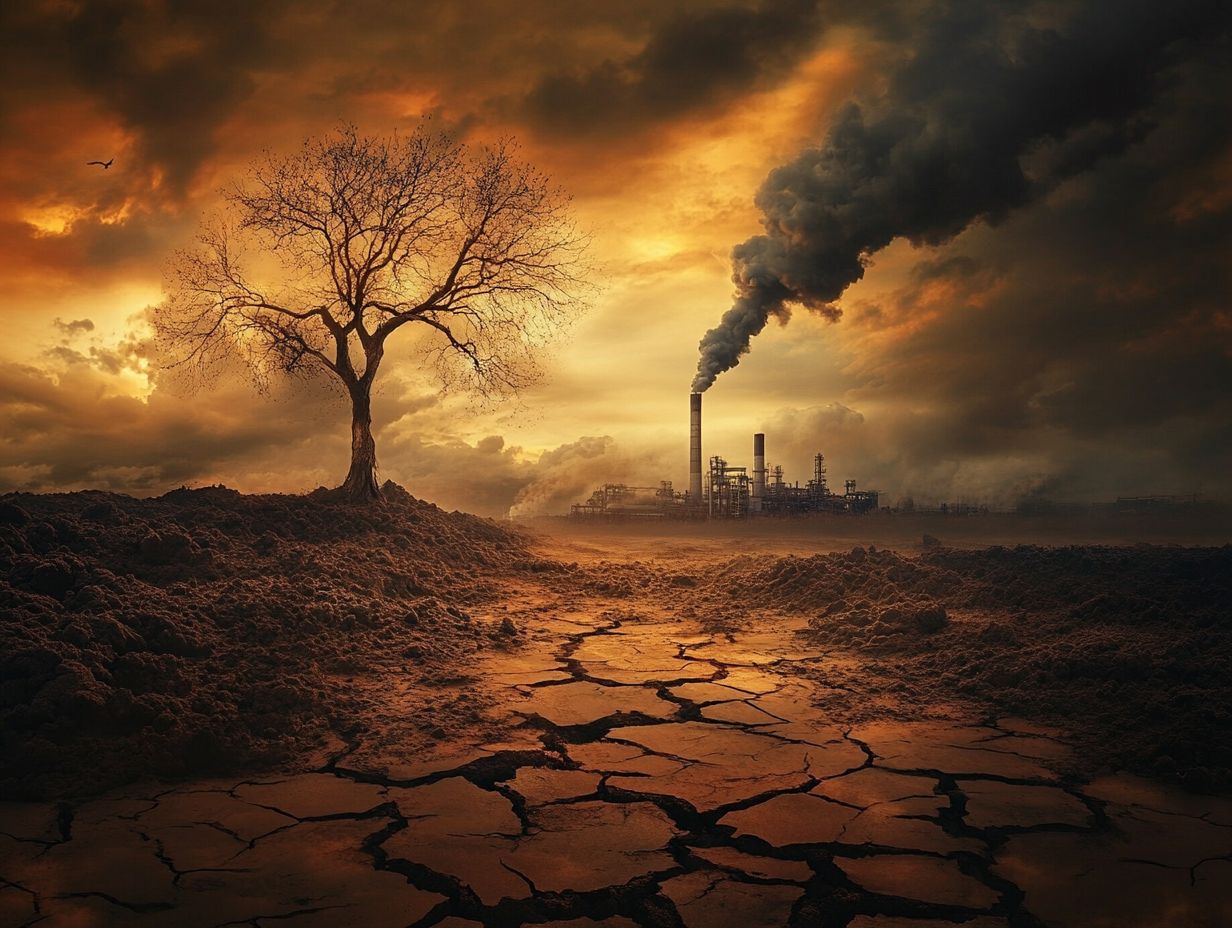What is Climate Change?
Climate change refers to the long-term shifts in an area’s weather patterns, encompassing temperature, precipitation, and wind. These changes can occur over decades, centuries, or even longer and may be attributed to both natural and human-made factors.
In response to these changes, the climate can experience alterations such as global warming, which is the gradual increase in the Earth’s temperature due to the greenhouse effect caused by elevated levels of carbon dioxide and other pollutants in the atmosphere.
What is the Primary Cause of Climate Change?
While natural factors play a significant role, human activity is the primary cause of climate change. Activities such as burning fossil fuels for energy, deforestation, and industrial production release greenhouse gases into the atmosphere. These gases trap heat from the sun and prevent it from radiating back into space, thereby increasing global temperatures and contributing to climate change.
According to a 2018 report by the Intergovernmental Panel on Climate Change (IPCC), human influence was the dominant cause of atmospheric, oceanic, and land warming between 1971 and 2010.
What are the Effects of Climate Change?
Climate change has numerous effects on the environment, weather patterns, and human health. Some of the most significant effects include:
- Global Warming: Rising temperatures worldwide, with certain regions experiencing more drastic increases than others.
- Extreme Weather Events: An increased frequency and intensity of storms, droughts, and heatwaves, leading to infrastructure damage and loss of life.
- Rising Sea Levels: Melting ice caps and glaciers are causing sea levels to rise, resulting in flooding in coastal areas.
- Ocean Acidification: Higher carbon dioxide levels are making oceans more acidic, which harms marine ecosystems.
- Loss of Biodiversity: Climate change threatens the survival of numerous plant and animal species, leading to extinction.
- Food and Water Scarcity: Changes in precipitation and temperature patterns negatively affect crop yields and water availability, resulting in food and water insecurity.
- Health Impacts: Climate change exacerbates existing health issues and creates new risks, such as heat-related illnesses and the spread of infectious diseases.
What are the Solutions to Climate Change?
Addressing climate change requires a multifaceted approach that includes reducing greenhouse gas emissions, increasing energy efficiency, and promoting sustainable practices. Potential solutions include:
- Transitioning to Renewable Energy Sources: Shifting from fossil fuels to solar, wind, hydroelectric, and geothermal energy can significantly reduce carbon emissions.
- Increasing Energy Efficiency: Implementing energy-efficient technologies in homes, businesses, and transportation can lower energy consumption and greenhouse gas emissions.
- Reforestation and Afforestation: Planting trees and restoring forests can absorb carbon dioxide from the atmosphere and help mitigate climate change.
- Sustainable Agriculture: Adopting sustainable farming and livestock production practices can reduce greenhouse gas emissions and improve food security.
- Carbon Capture and Storage: Developing technologies to capture and store carbon emissions from power plants and industrial facilities can decrease the amount of carbon dioxide released into the atmosphere.
- Reducing Waste: Implementing measures to minimize waste and promote recycling can help lessen greenhouse gas emissions associated with waste disposal.
What Can Individuals and Society Do to Combat Climate Change?
Individuals and communities can take several actions to help combat climate change, including:
- Reducing Energy Consumption: Turning off lights and appliances when not in use, using energy-efficient appliances, and minimizing heating and cooling needs can help reduce energy consumption.
- Using Public Transportation: Taking public transportation, carpooling, walking, or biking can decrease the number of cars on the road, thereby lowering greenhouse gas emissions.
- Supporting Sustainable Practices: Choosing sustainably sourced products, supporting local businesses, and reducing single-use plastics can help minimize the environmental impact of human activity.
- Advocacy and Education: Raising awareness about climate change, supporting sustainability-promoting policies, and educating others about the importance of environmental stewardship can foster a culture of sustainability.
What are the Most Current Statistics Describing the State of Climate Change?
According to the World Meteorological Organization’s 2022 report, the following statistics provide insight into the current state of climate change:
- The global mean surface temperature has increased by approximately 1.2 degrees Celsius compared to pre-industrial levels.
- The concentration of carbon dioxide in the atmosphere reached 414 parts per million (ppm) in 2020, the highest level in at least 800,000 years.
- The frequency of extreme weather events has increased, with the number of natural disasters reported to the United Nations Office for Disaster Risk Reduction rising from 3,000 in the 1960s to over 400,000 in the last decade.
- Sea levels have risen by approximately 3.3 millimeters per year since 1993, with the rate of rise expected to accelerate in the coming decades.
What Will Happen if Climate Change Continues at Its Current Trajectory?
The potential consequences of climate change, if it continues on its current trajectory, are severe. According to a 2019 report by the IPCC, the following scenarios are predicted if greenhouse gas emissions are not significantly reduced:
- The global mean surface temperature is expected to increase by 1.5 degrees Celsius above pre-industrial levels between 2030 and 2052 and could reach 2 degrees Celsius by 2050.
- The frequency and intensity of extreme weather events are anticipated to rise, with an estimated 2 billion people at risk of climate-related natural disasters by 2050.
- Sea levels are projected to increase between 0.3 and 1.2 meters by 2100, leading to widespread flooding of coastal areas.
- Biodiversity loss is expected to accelerate, with an estimated 1 million species facing extinction in the coming decades.
- Food and water insecurity are projected to worsen, with an estimated 1.8 billion people living in areas with absolute water scarcity by 2025.
Climate change is a pressing reality that poses a significant threat to the survival of all living organisms on Earth. Understanding the causes, effects, and potential solutions to climate change is essential for individuals and society to take meaningful action against this global crisis.
The Science of Climate Change

Climate change science encompasses the study of various interconnected phenomena, including the rising concentrations of greenhouse gases in the atmosphere, which contribute to global warming and the resulting ecological crisis that jeopardizes biodiversity and human livelihoods.
This field of science is primarily driven by anthropogenic factors, such as the burning of fossil fuels and deforestation, which lead to environmental degradation and significant changes in weather patterns.
Understanding the Causes and Effects
Understanding the causes and effects of climate change is crucial for addressing the ecological crisis we currently face. Global warming is primarily driven by the emission of greenhouse gases resulting from human activities, such as fossil fuel combustion and deforestation.
Fossil fuels, including coal, oil, and natural gas, are significant sources of carbon dioxide and methane that trap heat in the atmosphere, leading to rising global temperatures. Additionally, industrial agriculture and changes in land use are major sources of nitrous oxide and reduce the planet’s capacity to absorb carbon.
The consequences of climate change are profound: ecosystems are disrupted, extreme weather events become more frequent, air quality deteriorates, and public health is adversely affected as the prevalence of respiratory diseases increases. Furthermore, biodiversity loss undermines the intricate and delicate balance of ecosystems, resulting in plant and animal extinctions and the degradation of natural resources essential for human survival.
Current State of the Environment
The current state of the environment is defined by climate change, which is evidenced by trends such as rising sea levels, an increase in the frequency of extreme weather events, and a rapid loss of biodiversity.
Measuring the Impact of Climate Change

Measuring the impact of climate change involves comprehensive environmental assessments that evaluate the carbon footprint of various activities and apply climate forecasts to project potential future scenarios related to environmental degradation risk.
This process typically includes remote sensing, modeling, and simulations to gather accurate data on emissions and their effects on ecosystems. Analysts employ lifecycle assessments to examine the environmental footprint of products from production to disposal, thereby offering a deeper understanding of resource use and waste generation.
Risk assessments are crucial as they identify vulnerable regions and populations, enabling stakeholders to develop targeted adaptation and mitigation action plans. These systematic approaches not only reflect current challenges but also serve as a guide for policy-making aimed at promoting sustainability and climate resilience.
Potential Consequences of Inaction
The potential consequences of inaction on climate change are severe. Predictions suggest that failing to implement effective climate policies could result in environmental collapse, an increase in the number of climate refugees, and greater risks to food security and water scarcity worldwide.
Environmental and Societal Effects
The environmental and societal impacts of climate change are profound, affecting ecosystems and human health while exacerbating social inequality and undermining the ecosystem services that communities depend on for survival.
Rising temperatures and unpredictable weather patterns contribute to more frequent natural disasters, placing vulnerable populations at heightened risk for both physical and mental well-being. This phenomenon not only jeopardizes food security but also strains healthcare systems, as diseases spread more easily in warmer climates.
Additionally, the cascading effects of climate change disproportionately disadvantage marginalized communities, amplifying existing inequalities. Access to clean water, nutritious food, and safe housing is increasingly threatened, highlighting the urgent need to address these interconnected challenges.
The loss of critical ecosystem services—such as pollination and clean air—further exacerbates social disparities, making it imperative for collective action to protect both the planet and its inhabitants.
The Role of Human Activity in Climate Change

Human activity is a primary driver of climate change. Factors associated with human actions, such as the combustion of fossil fuels, deforestation, and industrial pollution, contribute to the dangerously high levels of greenhouse gases that result in global warming and environmental degradation.
Contributing Factors and Solutions
Identifying the factors contributing to climate change is essential for developing effective solutions, such as transitioning to renewable energy sources, adopting sustainable practices, and implementing mechanisms like a carbon tax to significantly mitigate the effects of climate change.
Understanding the roles of industrial emissions, deforestation, and reliance on fossil fuels in this global crisis is crucial for individuals and policymakers to collaborate on creating robust strategies to reduce environmental impact.
Shifting towards wind, solar, and hydroelectric power decreases the reliance on carbon-intensive energy and creates employment opportunities in emerging industries. Additionally, incorporating energy efficiency measures in homes, workplaces, and transportation systems can lead to significant reductions in waste and resource consumption.
These solutions can be further enhanced by strong economic policies that incentivize investments in renewable energy while penalizing activities that contribute to greenhouse gas emissions.
Mitigating the Effects of Climate Change
The effects of climate change can be alleviated through urgent climate action, emphasizing the necessity of achieving carbon neutrality by implementing environmental policies and adopting green technologies that promote sustainability.
Individual and Collective Actions

Both individual and collective actions play a crucial role in the fight against climate change, as personal decisions regarding sustainable practices can complement organized climate activism to create a more significant impact and enhance environmental awareness.
By consciously making choices in their daily lives—such as limiting waste, conserving energy, and utilizing renewable resources—individuals can amplify the effects of collective efforts. Communities can unite to organize local initiatives, including tree planting, recycling programs, and clean-up drives.
These programs not only contribute to environmental restoration but also foster a sense of community and shared responsibility for the issue. Joining forces with advocacy groups to lobby for policy changes enables citizens to combine their voices and push for legislation that addresses their concerns.
Ultimately, both individual and collective actions cultivate a sense of shared responsibility and community ownership over environmental issues, thereby strengthening the fight against climate change.
Preparing for a Changing Climate
Climate resilience refers to the capacity to anticipate, prepare for, and respond to hazardous events, trends, or disturbances associated with climate change. Strategies to enhance climate resilience include climate adaptation measures, such as disaster preparedness and improved environmental stewardship, which give the power to communities to effectively manage the impacts of climate change.
Adapting to the Future
Adaptation to future climate change involves strategies that enhance ecological resilience while supporting sustainable development goals. This approach ensures that communities are well-prepared for the challenges that lie ahead.
Adaptation strategies in the context of climate change include:
- sustainable agricultural practices
- restoration of natural habitats
- effective water management systems
- development of robust infrastructure
Local governments and stakeholders can incorporate community input alongside scientific research to prioritize adaptation initiatives that not only mitigate climate threats but also promote social equity and economic viability.
For instance, transitioning to green technologies can significantly reduce carbon emissions, while increasing urban biodiversity through the creation of green spaces can facilitate climate adaptation and enhance the quality of life for residents in urban areas.
Ultimately, the success of these adaptation strategies will depend on collaborative and proactive policies that integrate climate science with community-driven initiatives.


